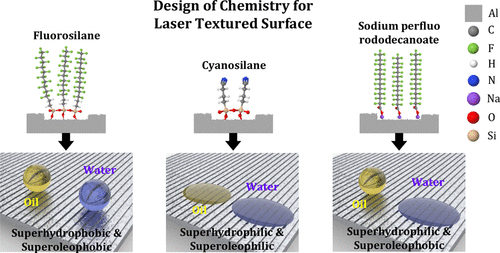当前位置:
X-MOL 学术
›
ACS Appl. Mater. Interfaces
›
论文详情
Our official English website, www.x-mol.net, welcomes your
feedback! (Note: you will need to create a separate account there.)
Design of Chemical Surface Treatment for Laser-Textured Metal Alloys to Achieve Extreme Wetting Behavior
ACS Applied Materials & Interfaces ( IF 8.3 ) Pub Date : 2020-04-03 , DOI: 10.1021/acsami.9b21438 Avik Samanta 1 , Wuji Huang 1 , Hassan Chaudhry 1 , Qinghua Wang 1 , Scott K. Shaw 2 , Hongtao Ding 1
ACS Applied Materials & Interfaces ( IF 8.3 ) Pub Date : 2020-04-03 , DOI: 10.1021/acsami.9b21438 Avik Samanta 1 , Wuji Huang 1 , Hassan Chaudhry 1 , Qinghua Wang 1 , Scott K. Shaw 2 , Hongtao Ding 1
Affiliation

|
Extreme wetting activities of laser-textured metal alloys have received significant interest due to their superior performance in a wide range of commercial applications and fundamental research studies. Fundamentally, extreme wettability of structured metal alloys depends on both the surface structure and surface chemistry. However, compared with the generation of physical topology on the surface, the role of surface chemistry is less explored for the laser texturing processes of metal alloys to tune the wettability. This work introduces a systematic design approach to modify the surface chemistry of laser textured metal alloys to achieve various extreme wettabilities, including superhydrophobicity/superoleophobicity, superhydrophilicity/superoleophilicity, and coexistence of superoleophobicity and superhydrophilicity. Microscale trenches are first created on the aluminum alloy 6061 surfaces by nanosecond pulse laser surface texturing. Subsequently, the textured surface is immersion-treated in several chemical solutions to attach target functional groups on the surface to achieve the final extreme wettability. Anchoring fluorinated groups (−CF2– and −CF3) with very low dispersive and nondispersive surface energy leads to superoleophobicity and superhydrophobicity, resulting in repelling both water and diiodomethane. Attachment of the polar nitrile (—C≡N) group with very high nondispersive and high dispersive surface energy achieves superhydrophilicity and superoleophilicity by drawing water and diiodomethane molecules in the laser-textured capillaries. At last, anchoring fluorinated groups (−CF2– and −CF3) and polar sodium carboxylate (−COONa) together leads to very low dispersive and very high nondispersive surface energy components. It results in the coexistence of superoleophobicity and superhydrophilicity, where the treated surface attracts water but repels diiodomethane.
中文翻译:

激光纹理化金属合金化学表面处理的设计,以实现极高的润湿性能
激光织纹金属合金的极高润湿活性因其在广泛的商业应用和基础研究中的卓越性能而受到广泛关注。从根本上说,结构化金属合金的极高润湿性取决于表面结构和表面化学性质。但是,与在表面上生成物理拓扑结构相比,对于金属合金的激光纹理化过程以调节润湿性的方法,人们很少探讨表面化学的作用。这项工作介绍了一种系统设计方法,用于修改激光织纹金属合金的表面化学特性,以实现各种极端的润湿性,包括超疏水性/超疏油性,超亲水性/超亲油性以及超疏油性和超亲水性的共存。首先通过纳秒脉冲激光表面纹理化在铝合金6061表面上创建微尺度沟槽。随后,将纹理化表面浸入几种化学溶液中,以将目标官能团附着在表面上,以实现最终的极端润湿性。固定氟化基团(-CF2-和-CF 3)具有非常低的分散和非分散表面能,导致超疏油性和超疏水性,从而导致水和二碘甲烷的排斥。具有非常高的非分散性和高分散性表面能的极性腈(-C≡N)基团的附着可通过在激光纹理化的毛细管中吸水和二碘甲烷甲烷分子来实现超亲水性和超亲油性。最后,将氟化基团(-CF 2-和-CF 3)和极性羧酸钠(-COONa)锚定在一起会导致非常低的分散性和非常高的非分散性表面能组分。它导致超疏油性和超亲水性并存,其中处理过的表面吸引水但排斥二碘甲烷。
更新日期:2020-04-03
中文翻译:

激光纹理化金属合金化学表面处理的设计,以实现极高的润湿性能
激光织纹金属合金的极高润湿活性因其在广泛的商业应用和基础研究中的卓越性能而受到广泛关注。从根本上说,结构化金属合金的极高润湿性取决于表面结构和表面化学性质。但是,与在表面上生成物理拓扑结构相比,对于金属合金的激光纹理化过程以调节润湿性的方法,人们很少探讨表面化学的作用。这项工作介绍了一种系统设计方法,用于修改激光织纹金属合金的表面化学特性,以实现各种极端的润湿性,包括超疏水性/超疏油性,超亲水性/超亲油性以及超疏油性和超亲水性的共存。首先通过纳秒脉冲激光表面纹理化在铝合金6061表面上创建微尺度沟槽。随后,将纹理化表面浸入几种化学溶液中,以将目标官能团附着在表面上,以实现最终的极端润湿性。固定氟化基团(-CF2-和-CF 3)具有非常低的分散和非分散表面能,导致超疏油性和超疏水性,从而导致水和二碘甲烷的排斥。具有非常高的非分散性和高分散性表面能的极性腈(-C≡N)基团的附着可通过在激光纹理化的毛细管中吸水和二碘甲烷甲烷分子来实现超亲水性和超亲油性。最后,将氟化基团(-CF 2-和-CF 3)和极性羧酸钠(-COONa)锚定在一起会导致非常低的分散性和非常高的非分散性表面能组分。它导致超疏油性和超亲水性并存,其中处理过的表面吸引水但排斥二碘甲烷。











































 京公网安备 11010802027423号
京公网安备 11010802027423号